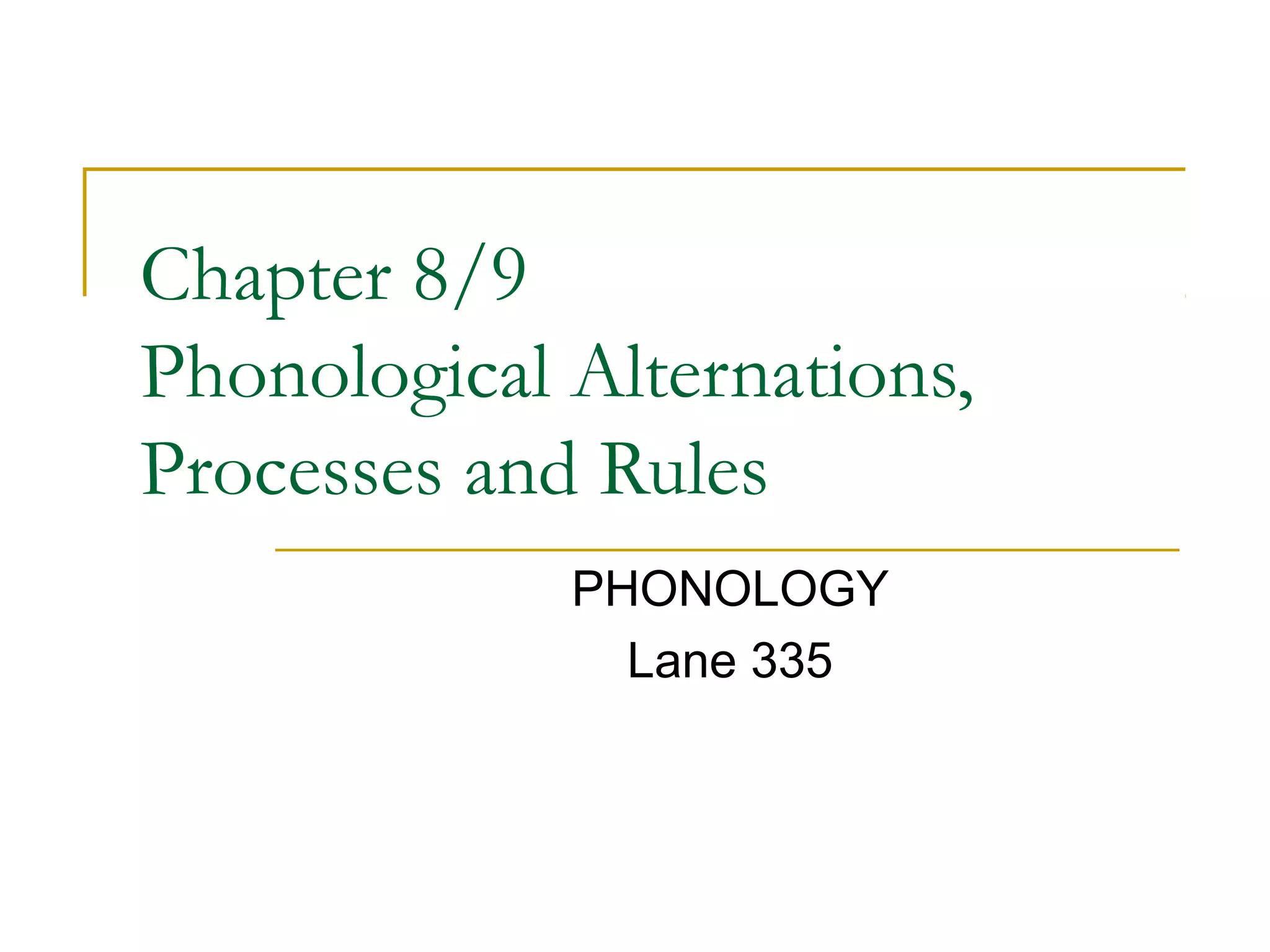The nasal prefix [n-] in Luganda undergoes a phonological process where it assimilates in place of articulation to the following consonant, becoming either [n], [ɲ], or [ŋ] depending on whether the following consonant is alveolar, palatal, or velar. This assimilation shows that the nasal prefix undergoes predictable alternations conditioned by the phonetic environment.



![Alternations
The focus of phonology is finding predictable
alternations between sounds; e.g. [p] & [ph
] in
English
There is one phoneme /p/
There is alternation in the representation of this
element on the surface (phonetic) level between
[p] & [ph
]
This alternation is determined by the
environment in which the phoneme occurs](https://image.slidesharecdn.com/phonologychapter9-151209130300-lva1-app6891/75/Phonology-chapter-9-4-2048.jpg)
![Processes
This alternation occurs due to or because of
some phonological processes
For example,
- The process involved in the alternation between
[p] & [ph
] is ‘aspiration’
In English, a voiceless stop is aspirated when it
occurs in syllable-initial position before a
stressed vowel (not following [s])](https://image.slidesharecdn.com/phonologychapter9-151209130300-lva1-app6891/75/Phonology-chapter-9-5-2048.jpg)
![Rules
We can represent processes which characterize
alternations by means of rules
Rules: rules are formal statements which express
the relationship between units on the different levels
of the phonological component.
For example, the rule for ‘aspiration’
- cont + syll
- voice [+ spread glottis]/ # ___ + stress
- del rel](https://image.slidesharecdn.com/phonologychapter9-151209130300-lva1-app6891/75/Phonology-chapter-9-6-2048.jpg)

![Alternation types
Phonological alternations come in many shapes & sizes
In (a), there is alternation between oral & nasal vowels
˷
a- [wɪt] vs. [wɪn]
In (b), ‘in’ is realized differently because it agrees in
place of articulation with the following consonant
b- ‘i [n]edible, i[n] Edinburah’ vs.
‘i [m]possible, i[m] Preston’ vs.
‘i [ŋ]conceivable, i[ŋ] Cardiff’](https://image.slidesharecdn.com/phonologychapter9-151209130300-lva1-app6891/75/Phonology-chapter-9-8-2048.jpg)
![Alternation Types
In (c), plural marker is realized as [s] or [z] or [ɪz]
depending on the nature of the preceding sound
c - ‘rat[s]’ vs. ‘warthog[z]’ vs ‘hors[ɪz]’
In (d), alternation in voicing for root final fricative
d- ‘lea[f]’ vs. ‘lea[v]es’
‘hou[s]e’ vs. ‘hou[z]es’
In (e), alternation between a stop vs. fricative
e- ‘electri[k]’ vs. ‘electri[s]ity’
‘medi[k]al’ vs. ‘medi[s]inal’](https://image.slidesharecdn.com/phonologychapter9-151209130300-lva1-app6891/75/Phonology-chapter-9-9-2048.jpg)

![Phonetically conditioned alternations
Alternations in (a) & (b) are conditioned purely by the phonetic
environment
In English, these are obligatory (difficult for speakers to avoid)
also includes:
- aspirated vs. non-aspirated voiceless stops ([ph
] in ‘pot’ vs. [p] in
‘spot’
- lateral & nasal release ( ‘beetle’ vs. ‘mutton’ )
- flapping (bɪɾər)
- clear vs. dark /l/ (‘late’ vs. ‘full’)
- the intrusive ‘r’ in non-rhotic English as in ‘tuna [r] alert’](https://image.slidesharecdn.com/phonologychapter9-151209130300-lva1-app6891/75/Phonology-chapter-9-11-2048.jpg)
![Phonetically & Morphologically
Conditioned Alternations
the form of the plural depends on the nature of the
last sound
If the noun ends in sibilant ([s], [z], [ʃ], [ʒ], [tʃ ], [dʒ]: it
takes [ɪz]
If the final sound is a voiceless non-sibilant: it takes
the voiceless alveolar fricative [s]
If the final sound is a voiced non-sibilant: it takes the
voiced fricative [z]](https://image.slidesharecdn.com/phonologychapter9-151209130300-lva1-app6891/75/Phonology-chapter-9-12-2048.jpg)
![Phonetically & morphologically
conditioned alternations
Don’t necessarily occur whenever the phonetic
environment alone is met; e.g. fence [fens], base [beɪs]
are counter-examples.
The final fricative agrees in voice with the preceding
sound only if it represents the plural marker (if there is a
morpheme boundary between the two segments)
This alternation is obligatory & automatic
When the alternation comes in a predictable way it’s
called productive
Other examples includes the past tense marker [t/d/ d]ɪ](https://image.slidesharecdn.com/phonologychapter9-151209130300-lva1-app6891/75/Phonology-chapter-9-13-2048.jpg)
![Phonetically, Morphologically, &
Lexically Conditioned Alternations
Examples in (e) & (d) (slide 9) above involve phonetic
conditioning:
- fricatives are voiced between voiced segments
leaf leaves
- velar [k] is fronted & fricativised to [s] (velar softening)
electric electricity
- also, some morphological conditioning
- only for a particular set of lexical items
- others include ‘vowel shift’ or ‘trisyllabic shortening’; e.g.
‘ins[eɪ]ne’ vs. ‘ins[æ]nity’ & ‘rept[aɪ]le] vs. ‘rept[ɪ]lian’](https://image.slidesharecdn.com/phonologychapter9-151209130300-lva1-app6891/75/Phonology-chapter-9-14-2048.jpg)

![Formal rules
A B/ X____ Y
For example, the flapping rule of American English: e.g. [bɪɾər]
/t/ [ɾ]/ V___ V
- stress
/t/ [ʔ]/ v___ # ; e.g. ‘cat’ & ‘hit’
Glottalisation: as in [m ntɪ ʔ], [mæpʔ]
- continuant [+ const glottis]/ ____ #
- voice](https://image.slidesharecdn.com/phonologychapter9-151209130300-lva1-app6891/75/Phonology-chapter-9-16-2048.jpg)
![Rules writing (Parentheses notation)
( ) is used to include optional elements in
rules
A B/ X (Y)___ Z
The rule for ‘l-velarisation’; e.g. ‘fell’, ‘bulk’
/l/ [ ]/ ___ (C) #ɫ](https://image.slidesharecdn.com/phonologychapter9-151209130300-lva1-app6891/75/Phonology-chapter-9-17-2048.jpg)
![Rules writing (Braces)
{ } represents an either/or relationship between two
environments
A B/ X ___ Y
Z
The rule for glottalising /t/ as in ‘cat’ [kӕʔ] or
‘petrol’ pe[ʔ] rol
/t/ [ʔ]/ ___ C
#](https://image.slidesharecdn.com/phonologychapter9-151209130300-lva1-app6891/75/Phonology-chapter-9-18-2048.jpg)

![Rules writing (superscripts & subscripts)
superscripts & subscripts express the
minimum & maximum numbers of segments
For example, the nonce word [nɪst]
/i/ [ɪ]/ C____ C² (subscript indicates the
minimum number)
/i/ [ ]/ C____ Cɪ ¹ ( superscript indicates the
maximum number)](https://image.slidesharecdn.com/phonologychapter9-151209130300-lva1-app6891/75/Phonology-chapter-9-20-2048.jpg)

![Feature-changing rules
Feature-changing rules: rules which affect individual
features or small groups of features; e.g. nasal
assimilation, flapping, glottalisation
another kind is dissimilation in which two adjacent
segments which share some features change to
become less like each other
Example,
‘chimney’ pronounced as [t mʃɪ li:] (nasal dissimilation)
[+nasal] [- nasal] / [+ nasal]____](https://image.slidesharecdn.com/phonologychapter9-151209130300-lva1-app6891/75/Phonology-chapter-9-22-2048.jpg)
![Deletion
Deletion is expressed in terms of a segment
becoming Ø (zero)
A Ø/ B ___#
In some varieties of English, word-final
coronal stop is deleted in a cluster; e.g.
‘hand’ [hæn], ‘list’ [l s]ɪ
- syll - syll ___ #
+ cons Ø/ + cons](https://image.slidesharecdn.com/phonologychapter9-151209130300-lva1-app6891/75/Phonology-chapter-9-23-2048.jpg)
![Insertion
Insertion involves inserting a segment that wasn't
originally there.
In some varieties of English, a schwa is inserted into
a final liquid + nasal cluster; e.g. /fɪlm/ becomes
[f ləɪ m]
+ cons
Ø ə/ + son ______ + cons
- nas + nas](https://image.slidesharecdn.com/phonologychapter9-151209130300-lva1-app6891/75/Phonology-chapter-9-24-2048.jpg)


![Exercise
Consider the behavior of the nasal prefix [n-] in Luganda.
m-bala I count n-tema I cut
m- pa I give n-numya u converse
m-mala I finish n-doppa I become
n-daga I show ŋ-kola I work
n-sika I pull ŋ-gula I buy](https://image.slidesharecdn.com/phonologychapter9-151209130300-lva1-app6891/75/Phonology-chapter-9-27-2048.jpg)